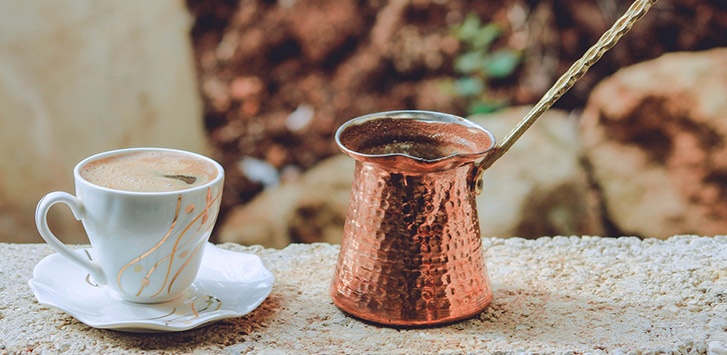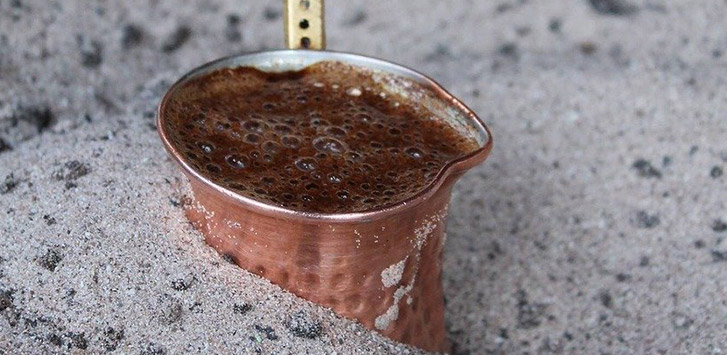
Turkish coffee is known the world over for its unique method of coffee brewing. Originating in Yemen (a country with its rich tradition of coffee growing), this brewing style became popularized under Ottoman Empire (now modern-day Turkey, hence the name) as its brewing method was followed under strict interpretations of the Qur’an.

This was due to coffee being viewed as a drug and considered forbidden for consumption. Fortunately for the world, the drink’s immense popularity across the Empire forced the Sultan’s hand to remove the prohibition, and coffee consumption spiked throughout the Ottoman empire.
What is Turkish Coffee?
While the country of Turkey may lend its name to this style of coffee, Turkish coffee is in actuality, a method of coffee brewing involving very finely ground coffee. The powered coffee is then mixed with sugar and water, brought to a boil in a special Turkish coffee maker called a cezve in Turkey (ibrik in other places). After boiling, it is then served in special cups, almost like espresso cups, called kahve finjanı.

After brewing, the coffee is served alongside a cup of cold water and sweets like Turkish delights, chocolate, or similar types of treats. Due in part to the coffee’s very fine ground size, the grounds remain within the drink and are usually consumed unlike other brewing methods like drip coffee or espresso.
What Do You Need to Brew Turkish Coffee?
In the most ideal situations, traditional Turkish coffee is brewed using ibrik or cezve (which can be easily bought), but if you don’t have one readily available and want to brew Turkish coffee now, a regular saucepan can work just as well.
Additionally, you will need to have fresh green coffee beans to roast and grind. We recommend either a Yemeni bean or an African based arabica like our Ethiopian Harrar to get the full depth of flavor when brewing Turkish coffee.
Finally, you will need sugar, a teaspoon per cup of coffee, and if you would like to add some additional flavor to the brew, adding spices like cardamom or cinnamon to taste can elevate the whole experience.
Ingredient List
- An ibrik or saucepan
- Fresh green coffee beans
- 1.5 oz water, per cup of coffee used
- Sugar, 1 teaspoon per cup of coffee used
- Spices like cardamom or cinnamon, to taste
Roasting and Grinding Considerations
Before getting down to brass tax, there are two major considerations to consider before actually brewing up your Turkish coffee. The first is the roasting process itself and probably the most important aspect of this entire coffee preparation process, the grinding.
Let us touch on the roasting process first. While any bean is fine to use for this brewing style, we should offer the caveat that if you’d like to fully appreciate the full spectrum of flavor that Turkish coffee offers, we should point you in the direction of coffee beans that shine when they are medium roasts to dark roasts.
The other, and more important, issue is the grinding process. Arguably, this is the most important part of the entire process that will set yourself up for success when preparing this style of coffee. Most coffee grinders, unfortunately, lack the appropriate grind settings to achieve the super fine grind that Turkish coffee is brewed with.
To achieve a super fine grind that Turkish coffee usually requires a hand grinder to achieve the sugar-like fineness that Turkish coffee is made with.
Brewing Instructions
After appropriately grinding your coffee beans, brewing Turkish coffee is surprisingly easy. If you know how to boil water, you are already halfway there to creating a delicious cup of coffee. The process is the same, even if you do not have an ibrik. So, assuming you have a small saucepan, brewing Turkish coffee is as follows.
Our Turkish Coffee Recipe
- Bring water and sugar to boil over medium heat
- Once boiling, remove from heat and add your coffee grounds. At this stage, you can also add spices like cardamom or cinnamon to taste.
- Return the coffee mixture to the heat and allow it to come to a boil. Once foaming, remove from the heat.
- Return to the heat and allowing it foam and remove from the heat for the final time.
- Pour the coffee into small espresso cups. Allow the coffee grounds to settle to the bottom before serving.
Serving Turkish Coffee

Like this brew style, serving Turkish coffee also its own set of rules or “best practices” that are in place to enhance the overall drinking experience.
After the coffee grounds have settled to the bottom of the cup and before you take your first sip of Turkish coffee, ice water is served alongside to cleanse one’s palate. Doing so, allows the full depth of the coffee’s flavor to be savored. Once you have taken the first sip, you do not necessarily need to keep cleansing your palate after each sip.
The other thing that is commonly served alongside Turkish coffee are sweets such as chocolates or most appropriately, Turkish delights. These desserts enhance the inherent sweetness of Turkish coffee while introducing other flavors into the mix.
Frequently Asked Questions
Is There a Specific Type of Coffee Bean to Use?
One of the best parts about making Turkish coffee is that you can use any coffee beans you already enjoy. That being said, a few general guidelines from us can make the most of this brewing style. The first is that Turkish coffee is made almost exclusively with arabica beans. The second being is that you should choose a bean the stands up well to medium and dark roasts. If you want to be authentic and have the full experience a Yemeni coffee bean is the way to go.
How Do I Get that Thick Foam on Top?
Because we based our cooking instructions on using a saucepan rather than the traditional cezve, you may have issues achieving the characteristic foamy top of Turkish coffee. Because the sugar, water, and coffee mixture are mixed through the smaller cezve, the mixture attains its foam top easier, however in a wider saucepan, this may be not possible.
Using a saucepan, once you have the three ingredients together in the sauce, give them a quick mix, but be sure to not overmix. After the first pour, you can mix it once again because the foamy top should already be there.
Do I Need Those Small Cups (kahve finjanı) to Serve Turkish Coffee?

Not really, espresso cups will do the job as there are just a bit larger than the more traditional Kahve Finjanı cups that Turkish coffee is served in. Kahve finjanı cups are a bit difficult to source inside the US, so if you wanted to get them, you’ll have to go through websites like Pasabache to acquire them.
What if People Have Different Sugar Preferences?
There are two ways to best go about this; either make multiple servings using different saucepans/cezves or the second (and easier) option is split the serving into two portions. Boil your coffee and water (without sugar) after boiling, split the mixture into two coffee pots. Resume boiling the second pour as you normally would without sugar and then serve. For the second pot, add sugar and mix before the second boil, and serve normally.
With a little creative ingenuity, making Turkish coffee at home is not particularly hard or difficult. Given the brewing style’s flexibility, you can customize it just like would with more conventional brewing methods like pour-over or drip coffee. It can be a rewarding experience to continue hundreds of years old brewing tradition that is enjoyed the world over while treating yourself to a decadent cup of coffee.